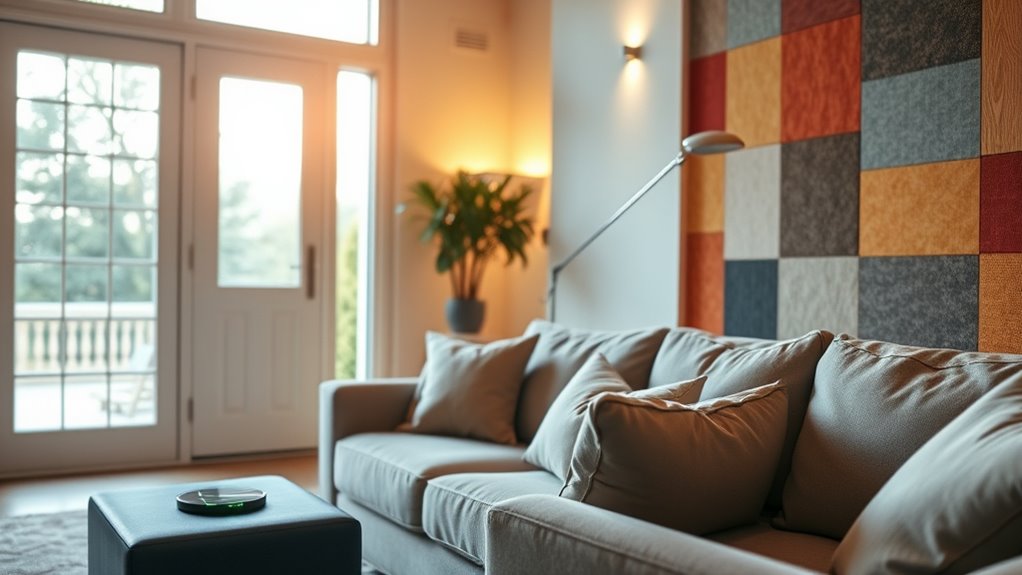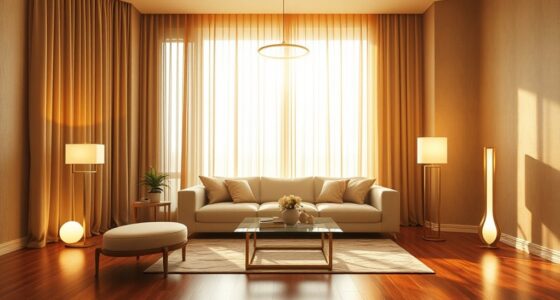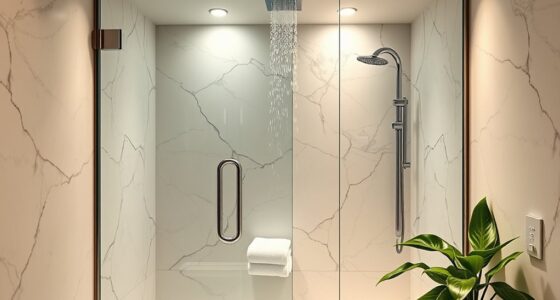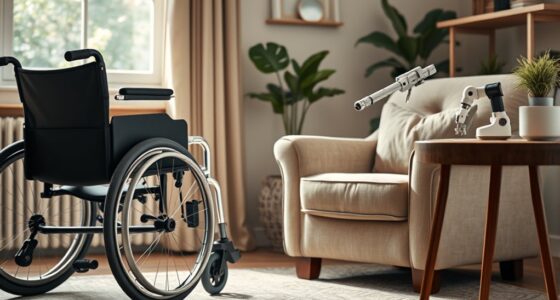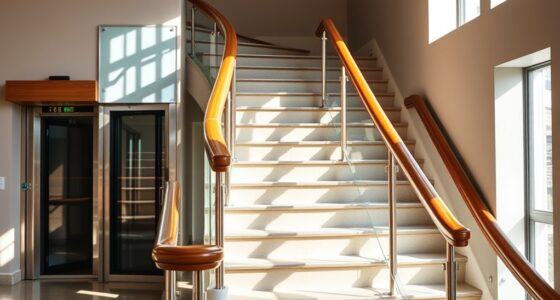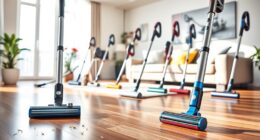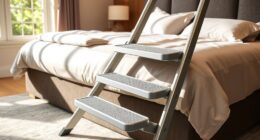To create a hearing-friendly home, focus on installing visual alerts like flashing lights for doorbells and alarms, and place them where they’re easily seen. Improve sound clarity by reducing background noise with soundproofing, rugs, and acoustic panels. Choose assistive devices that suit your needs, and design your space to minimize echo and noise leaks. Keep exploring for practical tips to make your home more inclusive and comfortable.
Key Takeaways
- Install flashing lights for doorbells, alarms, and phone calls to provide visual notifications for hearing-impaired residents.
- Use acoustic treatments like soundproofing, carpets, and acoustic panels to reduce background noise and echo.
- Position visual alert devices where they are easily visible, ensuring proper placement, brightness, and contrast.
- Incorporate visual signals with color-coding to differentiate notifications and enhance clarity.
- Seal gaps around doors and windows to minimize external noise intrusion and improve overall sound quality.
Understanding the Needs of Hearing-Impaired Individuals
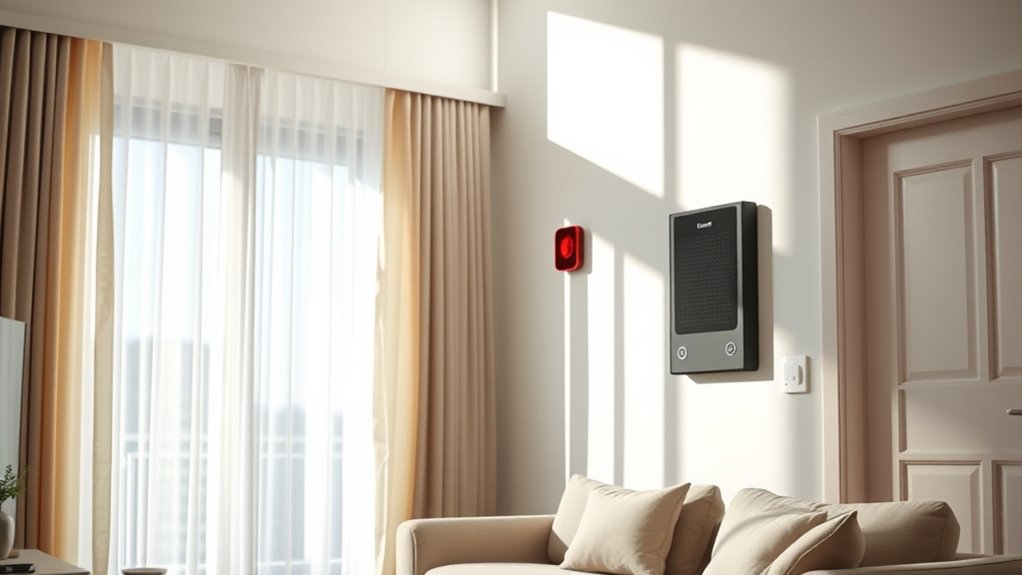
Have you ever wondered what it truly takes to make a home accessible for hearing-impaired individuals? Understanding their needs begins with recognizing that hearing loss affects how they perceive sound and communicate. You should consider effective communication strategies, like facing them when speaking, speaking clearly, and reducing background noise. It’s essential to be patient and attentive, ensuring they feel included and understood. Regularly check in to see if they need assistance or preferred methods of communication. Remember, hearing loss varies from person to person, so customizing your approach makes a big difference. Additionally, incorporating visual alerts such as flashing lights for doorbells or phones can significantly improve safety and awareness. By understanding these needs, you create a supportive environment that fosters better interaction and comfort for hearing-impaired family members or guests.
Incorporating Visual Notification Systems in Your Home
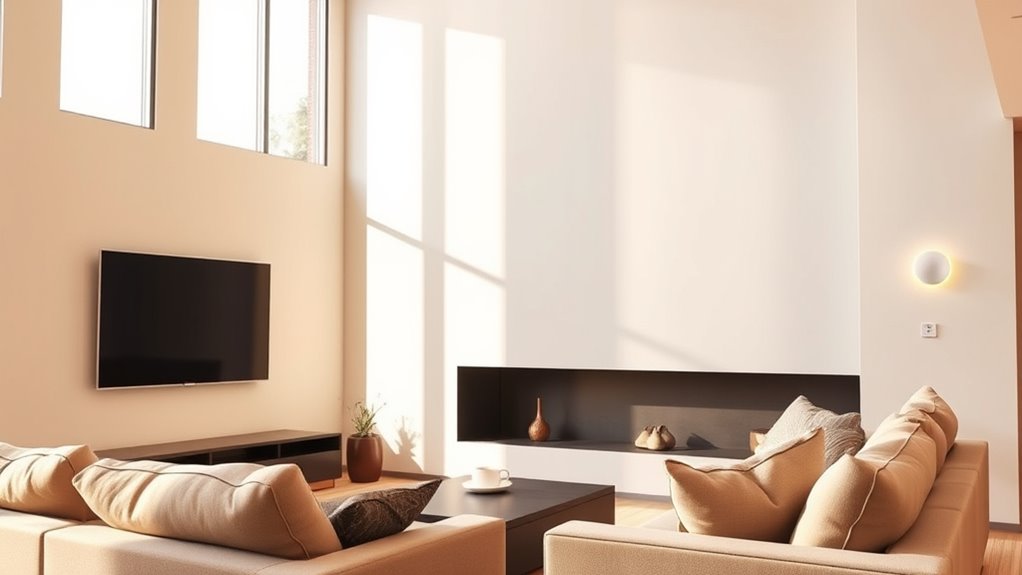
To guarantee hearing-impaired individuals don’t miss important alerts, incorporating visual notification systems into your home is essential. Well-designed visual alert systems use notification design to communicate effectively through visual cues. These systems can include flashing lights, color-coded signals, or displays that alert you to doorbells, alarms, or phone calls. When choosing visual alert systems, contemplate placement, brightness, and contrast to ensure visibility in different lighting conditions. Proper notification design makes alerts intuitive and easy to recognize. Additionally, integrating multiple alert types can enhance safety. Here are key points to consider:
- Use flashing lights for doorbells and alarms
- Implement color-coded signals for different notifications
- Position visual alert devices where they’re easily seen
- Understanding visual signaling techniques can improve the effectiveness of your alert system
Enhancing Acoustic Environments for Better Sound Clarity
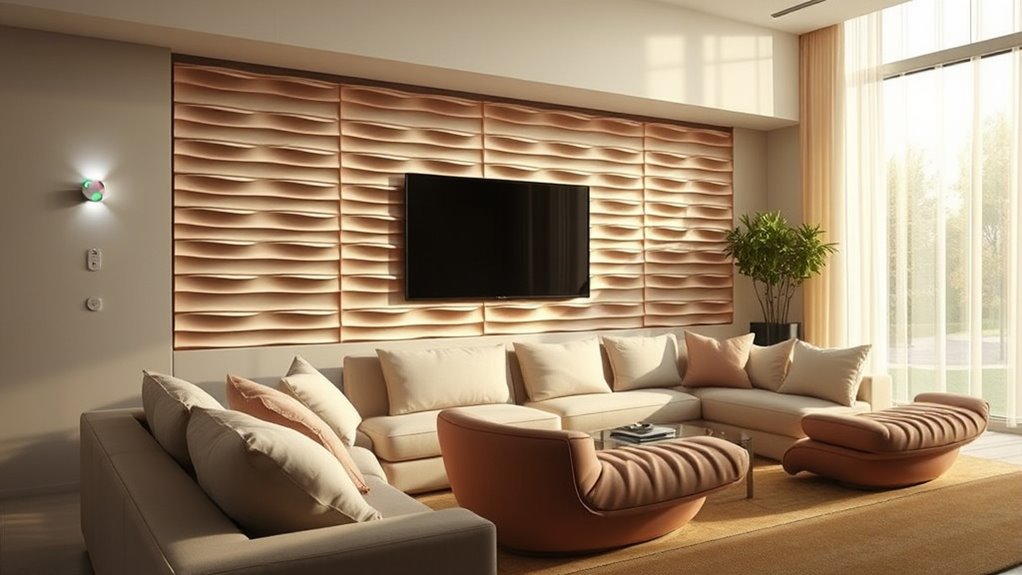
Creating an ideal acoustic environment is essential for ensuring clear sound quality in your home, especially for those with hearing impairments. You can improve clarity by implementing soundproofing strategies to reduce background noise and echo. Start by sealing gaps around doors and windows to block external noise. Consider adding rugs or carpets to absorb sound and prevent reverberation. Proper acoustic panel placement is also vital; position panels on walls where sound reflections occur most, typically behind speakers or near common noise sources. These panels help control sound diffusion and enhance speech intelligibility. Additionally, understanding the contrast ratio of your audio setup can significantly impact sound clarity and perceived quality. Combining soundproofing with strategic acoustic panel placement creates a calmer, more focused auditory environment, making it easier to understand conversations and enjoy your home without distraction.
Selecting Appropriate Assistive Listening Devices
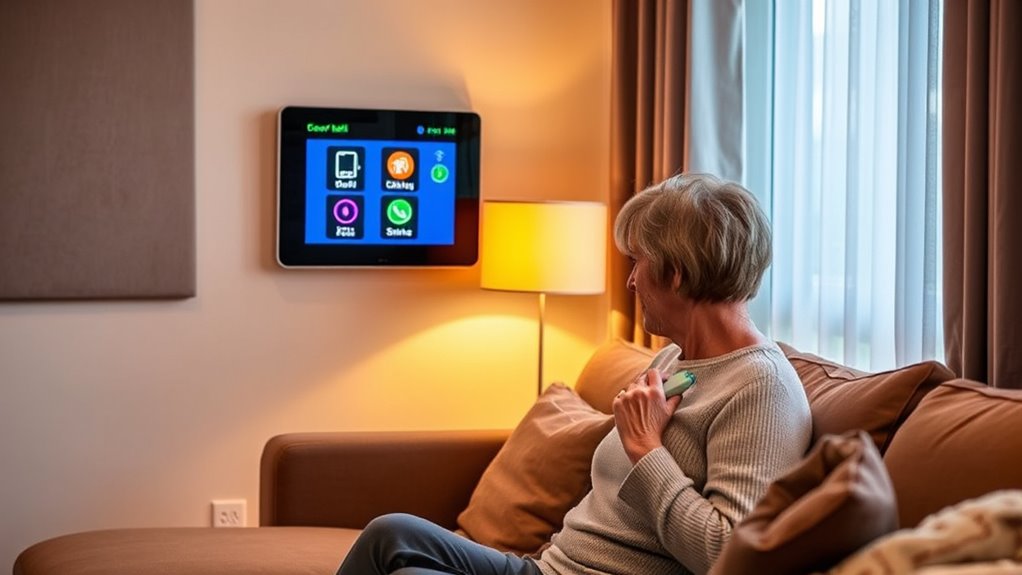
Choosing the right assistive listening device depends on your specific hearing needs and lifestyle. You’ll find options like hearing aids, personal amplifiers, and cochlear implants, each suited for different situations. To make the best choice, consider the technology features and how they fit into your daily routines. Additionally, exploring acoustic environments can help determine the most effective device for your settings.
Types of Assistive Devices
Selecting the right assistive listening device depends on your specific hearing needs and lifestyle. You have several options to enhance your hearing experience:
- Wireless connectivity: Devices like FM systems or Bluetooth-enabled hearing aids help you connect seamlessly to phones, TVs, or other audio sources.
- Personal amplifiers: Compact devices that amplify nearby sounds, ideal for one-on-one conversations or small groups.
- Alert systems with emergency alerts: Devices that use visual signals or vibrations to notify you of alarms or important sounds, ensuring safety even if you miss auditory cues.
- Devices with love, guidance, and support features can provide reassurance and comfort in everyday situations.
Choose devices that integrate well with your daily routine and environment. Prioritize features like wireless connectivity and emergency alerts for a all-encompassing, hearing-friendly home.
Choosing the Right Technology
When it comes to enhancing your hearing environment, picking the right assistive listening devices makes a big difference. Focus on devices with smart home integration, so they seamlessly connect with your existing systems. Wireless connectivity is essential, allowing your devices to sync effortlessly with smartphones, TVs, and other gadgets. Consider options that offer easy control and customization, ensuring you can tailor the sound settings to your preferences. Look for devices with reliable Bluetooth or Wi-Fi capabilities, which enhance convenience and reduce setup hassle. The right technology should be user-friendly, adaptable, and compatible with your home’s ecosystem. Ensuring compatibility with assistive listening devices can significantly improve your overall experience and accessibility. By choosing devices with these features, you create a more accessible, connected space that supports your hearing needs effectively.
Designing a Space That Minimizes Echo and Background Noise
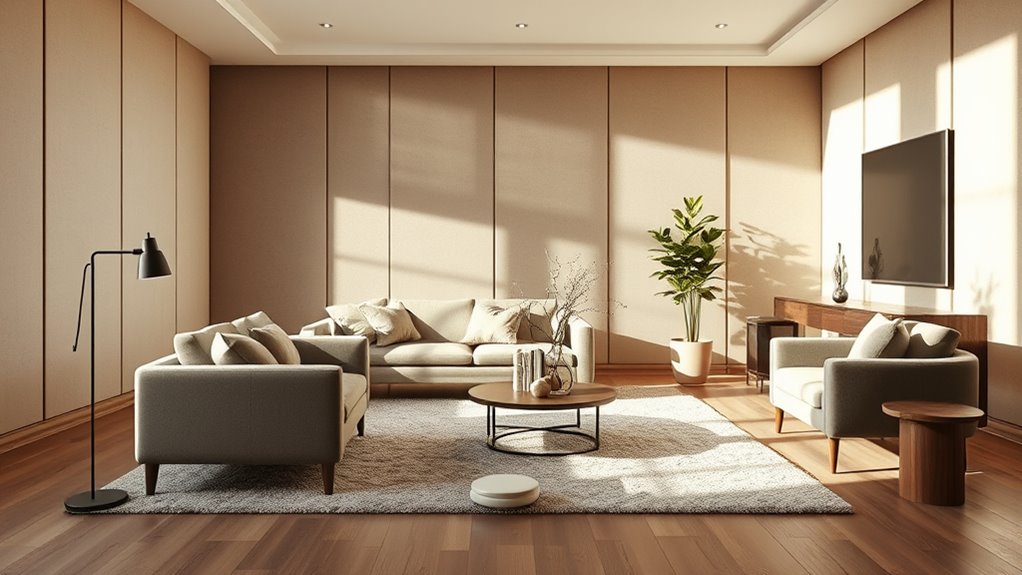
Creating a space that minimizes echo and background noise begins with understanding how sound reflects and travels within a room. To reduce unwanted noise, you should explore soundproofing techniques and acoustic treatment options. These methods help absorb or block sound, making your space more hearing-friendly. Focus on:
- Adding soft furnishings like rugs, curtains, and upholstered furniture
- Installing acoustic panels or foam to absorb sound reflections
- Sealing gaps around doors and windows to prevent noise leaks
- Considering GMC tuning techniques to optimize sound quality and reduce unwanted noise transmission through vehicle modifications
Practical Tips for Creating an Inclusive and Comfortable Living Space
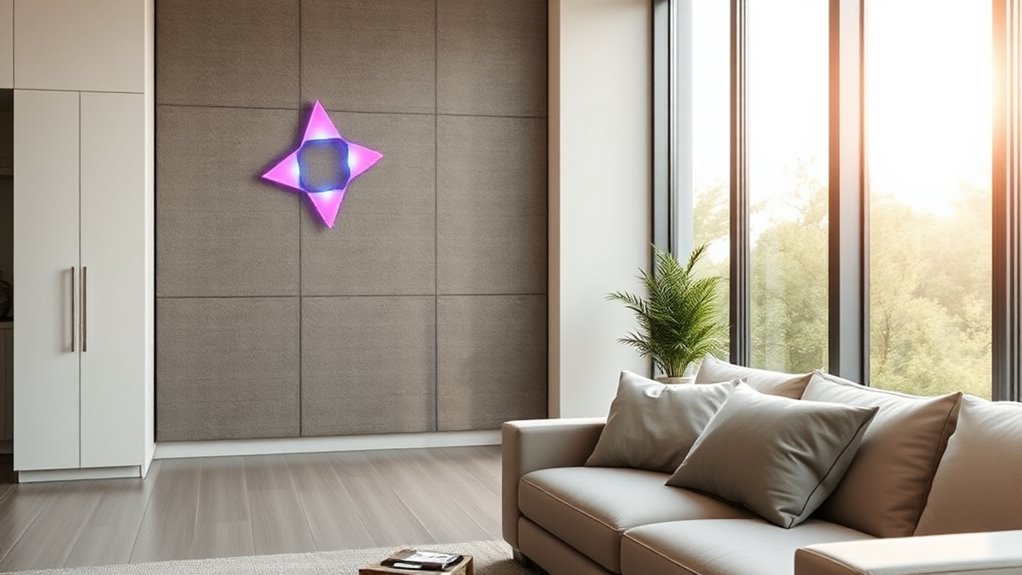
Designing a living space that feels inclusive and comfortable involves more than just soundproofing. You can enhance accessibility by thoughtfully using decorative lighting to provide clear visual cues and improve visibility. Proper lighting helps everyone feel safe and aware of their surroundings. Additionally, strategic furniture placement plays a crucial role in creating an inviting environment. Position furniture to facilitate easy movement and clear lines of sight, reducing potential obstacles or hazards. Keep pathways open and avoid clutter that could cause confusion or accidents. Incorporate comfortable, versatile furniture that encourages social interaction and relaxation. Maximizing space and organization can also contribute to an accessible environment by ensuring that items are stored efficiently and intuitively. By combining well-placed furniture with thoughtful lighting choices, you create a space that’s welcoming and accessible for all, making daily living easier and more enjoyable.
Frequently Asked Questions
How Can I Customize Alerts for Different Family Members’ Needs?
You can customize alerts by setting up personalized notifications for each family member’s needs. Use a smart home system that allows you to create family-specific alerts, like flashing lights or vibrations, tailored to individual preferences. This way, everyone receives the right notification in the way that works best for them. Adjust settings easily through your app, ensuring each person stays informed without confusion or missed alerts.
What Are the Latest Innovations in Hearing-Friendly Home Technology?
You can explore the latest innovations like smart doorbells with visual alerts that notify you of visitors, even if you’re hard of hearing. Voice-activated assistants now integrate with hearing-friendly tech, allowing you to control alerts and sound settings effortlessly. These advancements create a more accessible home environment, ensuring you stay connected and aware without missing important cues, making daily life more comfortable and inclusive.
How Can I Balance Aesthetics With Functional Alert Systems?
You can balance aesthetics with functional alert systems by choosing decorative integration options that blend seamlessly into your home’s decor. Opt for minimalist design, which maintains a clean, unobtrusive look while providing essential alerts. Select devices with sleek, modern styles or customizable appearances to match your interior. By prioritizing subtle, stylish alert systems, you guarantee safety without compromising your home’s aesthetic appeal.
Are There Specific Materials That Improve Acoustics in Home Design?
When it comes to improving acoustics in your home, certain materials really make a difference. Soundproofing materials like mass-loaded vinyl and dense insulation help block noise, while acoustic paneling absorbs sound reflections. Think of it as keeping noise in check; adding plush rugs and fabric-covered furniture also boosts sound quality. These materials work together to create a cozy, quiet space where you can relax without disturbance.
How Do I Ensure My Home Remains Accessible During Power Outages?
To keep your home accessible during power outages, invest in backup power sources like generators or battery backups. These guarantee essential systems, such as lighting, alarms, and communication devices, stay functional. Incorporate emergency preparedness by creating a plan that includes accessible tools and supplies. Regularly test your backup systems and keep emergency kits ready. This way, you stay safe and connected, no matter what happens.
Conclusion
By embracing visual alerts and thoughtful acoustics, you’re building a sanctuary where every sound and signal becomes a guiding star. Your home transforms into a lighthouse, shining clarity through the fog of noise and silence. With each mindful choice, you craft a space that welcomes and supports, turning everyday moments into a symphony of comfort. In this haven, inclusivity isn’t just a goal—it’s the steady heartbeat that keeps everyone connected and safe.
